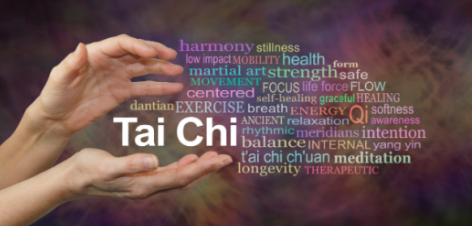Written by Maureen Ivusic
As legend tells it, an old monk sat quietly meditating on a mountainside when a snake and a crane began to fight. As he watched, he noticed the interplay of the animals – one attacking, one defending – playing out the natural balance of yin and yang. He sought to learn the movements of animals and wove them into a tapestry of energetic play. * While the true origins may be more mundane (or fantastic!), the resulting combination of forms became known as Tai Chi, or Grand Ultimate (taiji).
Tai Chi is not just the blending of movements but also of philosophies of ancient China. Drawing on the cultures of Taoism, Buddhism, and Confucianism, Tai Chi takes the best of each to develop its philosophy of Harmony. But if Tai Chi is simply Harmony, then what are we doing when we “play” Tai Chi? That flowing movement you see in the parks or in the movies is called Tai Chi Ch’uan (or taijiquan).
When we “do” baseball or basketball or football, we play that sport. The same is true for Tai Chi. Essentially, participants who play Tai Chi are practicing martial arts. Tai Chi, however, is considered an internal martial art. David-Dorian Ross, Tai Chi Master and creator of the TaijiFit Method, says it best: “Other martial arts teach us how to hurt each other; Tai Chi teaches us how to heal each other. Other martial arts speak of aggression; Tai Chi speaks of compassion. Other martial arts are rooted in violence; Tai Chi is rooted in benevolence. Other martial arts focus on human conflict and combat; but in Tai Chi we combat depression, aging and death.”
TaijiFit, also called Tai Chi Flow, is the practice or exercise of harmony. So, when we play Tai Chi using the TaijiFit Method, we are doing our “harmony exercise.” The best part about this method of learning Tai Chi is that there is nothing to “get right” – no form to memorize, no exact way to do the movement. Unlike when I learned Tai Chi and my Grand Master would put my hands in the correct position if I didn’t get it right myself. Then I’d practice that one posture / form for a week or two before moving on to the next one. It took three years for me to learn two Tai Chi Forms in this way (the Simplified / 24 Forms and the Long Chen Form).
I still teach the 24 Forms, but not in that traditional way. As is true of just about every cultural tradition, Tai Chi changed when exported to other countries. In the Greater Washington, DC, area, we can find traditional Chinese Tai Chi, as well as versions that hail from South Korea and Vietnam. I learned a Japanese Tai Chi Form that is particularly calming and meditative. Tai Chi can also be blended with other meditative traditions, such as yoga, or more energetic movements, such as HIIT.
What is it about Tai Chi that speaks to many cultures and many practices? Well, for one thing, it truly is a healing art. A quick search on PubMed.gov (the National Library of Medicine online repository of scientific research) returns over 66,000 studies and discussions on Tai Chi and health.
My focus has been fall prevention and brain health. According to a recent article in The Harvard Gazette, the physical benefits include improved balance, fall prevention, as well as pain management, improved cognition, and reduced stress. (1) “While Tai chi may offer senior practitioners inner peace, scientists also value it for its fundamental, physical benefits. In addition to improving balance, flexibility, and mental agility, it also reduces falls, the largest preventable cause of death and injury among older adults.”
And who can resist movements like these? Bamboo on the Mountain, Parting Wild Horse’s Mane, White Crane Spreads Its Wings. You can experience these and many others in a 45-minute Tai Chi Flow class, where we move continuously for 30-40 minutes after some stretching and warmups.
You can find a Tai Chi Flow class right in Poolesville! Poolesville Seniors sponsors my in-person class on Tuesdays at 10:30 a.m. Register online at poolesvilleseniors.org. The class will also be simulcast on Zoom for those who prefer virtual class.
* There’s a bit of embellishment, but that’s the beauty of legends. The author takes full responsibility for creative license.
1https://news.harvard.edu/gazette/story/2017/04/tai-chi-can-prevent-elderly-from-falls-add-mental agility/

